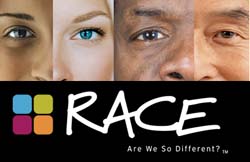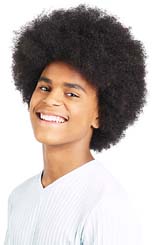|
Intermix.org.uk is a website for the benefit
of mixed-race families, individuals and anyone who feels they have a multiracial
identity and want to join us. Our mission is to offer a view of the mixed-race experience, highlighting icons, film, books, poetry, parenting techniques, celebrities, real lives and much more. Our online forums are a great place to meet others, ask questions, voice your opinions and keep in touch. Sign up for our monthly newsletter and delve into our pages. Want to join in? Become an Intermix member to take part: |
Are We So Different?
 Exhibition gives a better understanding of race.
Exhibition gives a better understanding of race.
A new exhibition at the Science Museum of Minnesota has been put together to challenge what we think about race. RACE: Are We So Different helps visitors understand what race is and what it is not.
'I want people to have a better understanding of race, what it is,' says Robert Garfinkle, the Science Museum's program director for special projects. 'if we have a better base line of information in the community, then our conversations about
race can be richer and deeper and more meaningful.'
The exhibit is broken down into three parts: science, history, and everyday life experiences. There are hands-on tools that depict skin tones and videos where people talk about their culture clashes.
On opening day the Exhibition was visited by about 75 high school students from Henry Sibley High School in Mendota Heights and sparked many conversations about race.
Amy Bleecker knows all about white privilege, but the 16-year-old brown-eyed strawberry blonde wants no part of it, particularly because her mother doesn't enjoy it. She is Hispanic.
Amy characterizes herself as 'in the middle,' not totally accepted by some whites when they learn of her heritage, not accepted by many Hispanics because she doesn't look like most of them.
'Don't be in denial,' Amy says. In our society, how you're treated 'all comes down to race.'
Jessica Henderson Daniel, director of training in psychology at Harvard-affiliated Children's Hospital in Boston, says people often don't talk to their children about race.
'There is a lack of familiarity with the subject, even among highly educated people,' she said. And children often don't ask questions because 'it gets telegraphed to them that this is not something we talk about,'
'Children of colour become aware of something called race at about three,' says Jessica. 'For Caucasian children, whose skin colour rarely determines how they're treated, the awareness comes at about five.'
Jessica says that children need to be taught that a person's colour has nothing to do with the kind of person they are.
‘We have not taught people history in a way that puts race in context,’ says Jessica, she recommends that parents get their children books ‘validating the achievements of people that look like them.’ Then, when they hear remarks disparaging people of a certain race ‘they'll have a tape going in their heads saying, 'That's not true.”
RACE: Are We So Different will be at the Science Museum of Minnesota until May 6. Click here to visit the website and find out more.
Source:
